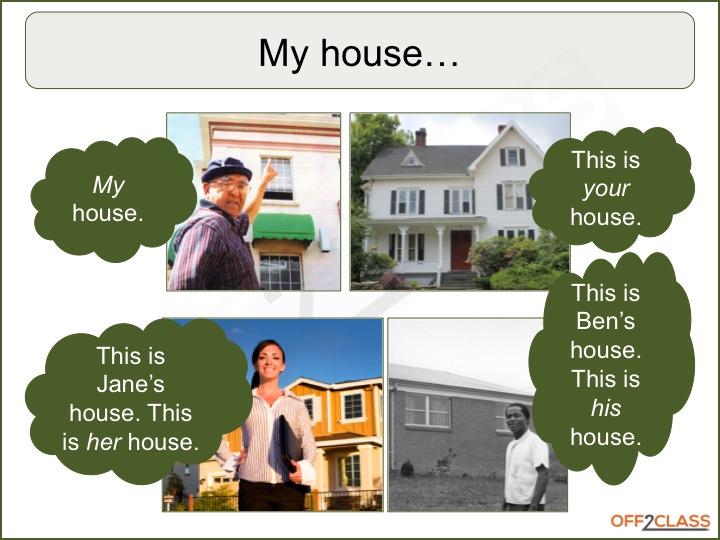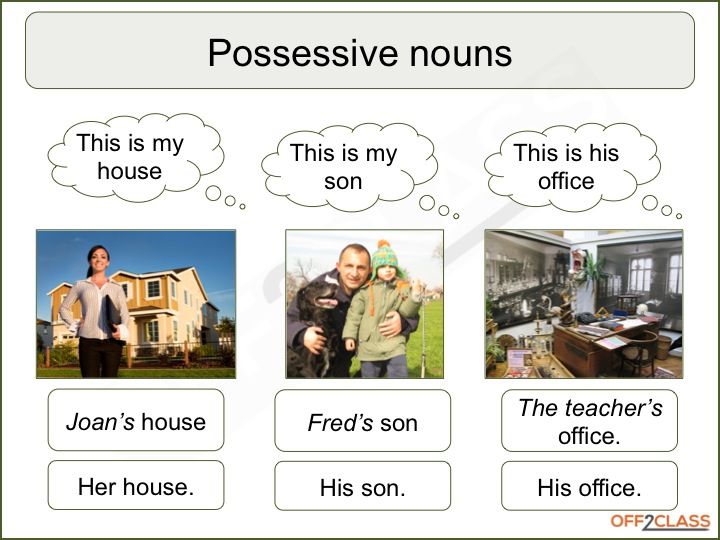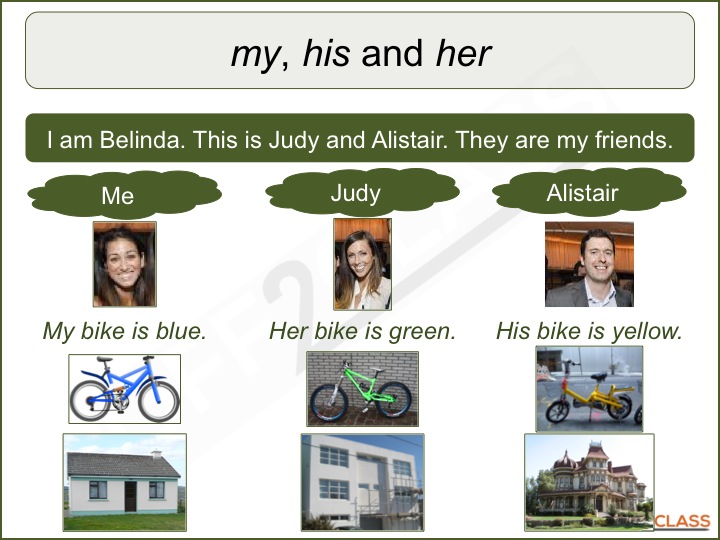
Possessive Adjectives Possessive adjectives, Possessives, Adjectives
Grammar Possessive Adjectives are my, your, his, her, its, our, and their. Possessive Pronouns are mine, yours, his, hers, its, ours, and theirs. Explanation A possessive adjective is not used alone. It's my book. Possessive pronouns can be used alone. It's mine. A possessive adjective describes the noun, so it comes with the noun, not alone.

How To Teach Possessive Adjectives I… English ESL powerpoints
How to Teach Possessive Adjectives in a Fun Way Once your students have an understanding of subject pronouns and object pronouns, it is important to introduce them to possessive adjectives. We at Off2Class want to help you do this as easily as possible! This article will cover how to teach possessive adjectives in a fun and effective way.

Possessive adjectives Love2Learn Grammar for kids, English phonics, English lessons for kids
1.5.1 Possessive Adjectives Lesson Plan. In the BrainPOP ELL movie, My Mom's Pictures (L1U5L1), Ben shows Moby old photos of his family, using possessives to describe the people in the pictures. In this lesson plan, adaptable for grades K-8, students use possessive adjectives to describe images from the movie, as well as their own photos.

How to teach possessive adjectives and nouns! Off2Class
How to teach possessive adjectives By: Alex Case | Category: English Grammar | Topic: Adjectives and Adverbs Last Updated: 7th Jun. 2023 Simple and fun ways of teaching and practising "my", "your", "his", "her", "its", "our" and "their", with 16 possessive adjective games. Contents

How to teach possessive adjectives and nouns! Off2Class
Possessive Adjectives (Beginner) English with Teacher Tom - YouTube 0:00 / 9:19 Possessive Adjectives (Beginner) English with Teacher Tom ESLTeacherTom 337K subscribers Subscribe 3K Share.

How To Teach Possessive Adjectives I… English ESL powerpoints
This article will teach you everything you need to know about what they are and how to use them correctly in your writing. In short: A possessive adjective is a word that modifies a noun or pronoun to show possession or a relationship.. Possessive adjectives show who the noun belongs to, what the relationship is between the subject and the.

Oneclick print document Possessive adjectives, Possessive pronoun, Pronoun worksheets
Overview Welcome to our beginner ESL lesson on possessive adjectives. In this lesson, we use a basic conversation to explain possessive adjectives in a way that learners can easily understand. By the end of this session, students should be familiar with the function of possessive adjectives and use them correctly in their communication.

Possessive adjectives and pronouns Interactive worksheet Possessive adjectives and pronouns In
How To Teach Possessive Adjectives In A Fun Way - Off2Class Lesson Plan Off2Class 657 4 6 0 1/10 Let's do English ESL general grammar practice. What does this lesson plan include? This lesson plan includes useful tables with information on subjects and po…

How To Teach Possessive Adjectives I… English ESL powerpoints
Possessive adjectives are used in place of proper names. Place adjectives directly before the noun they modify. Possessive adjectives are very similar in usage to possessive pronouns. Possessive adjectives are used when the context is clear who is in possession of an object. Note the similarity in form between possessive adjectives and pronouns.

Possessive Adjective All You Need to Know about Possessive Adjectives • 7ESL Possessive
After some freer practice of gapfills and matching, we introduce two challenging concepts 1) the use of -'s without a noun (as in Peter's - implied car/book/hat), and 2) the apostrophe for plural nouns that end in -s ( students' homework). These are two very difficult concepts for beginner ESL students.

Possessive adjectives multiple choice for young learners Possessive adjectives, Possessives
Possessives Do you want to practise using possessives in English? Help Possessives We can use possessives to say who things belong to. I've got a pen. My pen is red. We've got a car. Our car is fast. She likes her teachers. How to use them To say who things belong to, we use: I = my you = your he = his she = her it = its we = our they = their

How To Teach Possessive Adjectives I… English ESL powerpoints
We use possessive adjectives with a noun to show that something belongs to somebody. My sister lives in Paris. Is that your bag under the chair? I don't know his brother. Her name is Jenna. This restaurant is famous for its pizza. Our apartment is on the top floor Their house is next to mine. We use possessive adjectives to talk about appearance.

How To Teach Possessive Adjectives I… English ESL powerpoints
In terms of possessive adjective definition, it's a word that clarifies ownership (who owns something). They can only be used before the noun they refer to. It typically comes before a noun to express who or what owns the noun, such as in the phrases "my house" and "our study group."

Possessive adjectives in 2021 Possessive adjectives, Nouns activities, Pronoun activities
Level: beginner We use possessive adjectives: to show something belongs to somebody: That's our house. My car is very old. for relations and friends: My mother is a doctor. How old is your sister? for parts of the body: He's broken his arm. She's washing her hair. I need to clean my teeth. Possessives: adjectives Be careful!

Possessive adjectives reading activity 2 worksheet English Grammar Exercises, Teaching English
The possessive adjectives are my, your, his, her, its, our, their, and whose. A possessive adjective sits before a noun (or a pronoun) to show who or what owns it. For example: Where is Jane? I have her hat. (Here, the possessive adjective "her" sits before the noun "hat" to tell us that it belongs to Jane.) The boys have left their toys in the.

How to teach possessive adjectives and nouns! Off2Class
Possessive adjectives are used to show possession or ownership of something. While we use them when we refer to people, it is more in the sense of relationship than ownership. The possessive adjectives in English are as follows: The possessive adjective needs to agree with the possessor and not with the thing that is possessed.